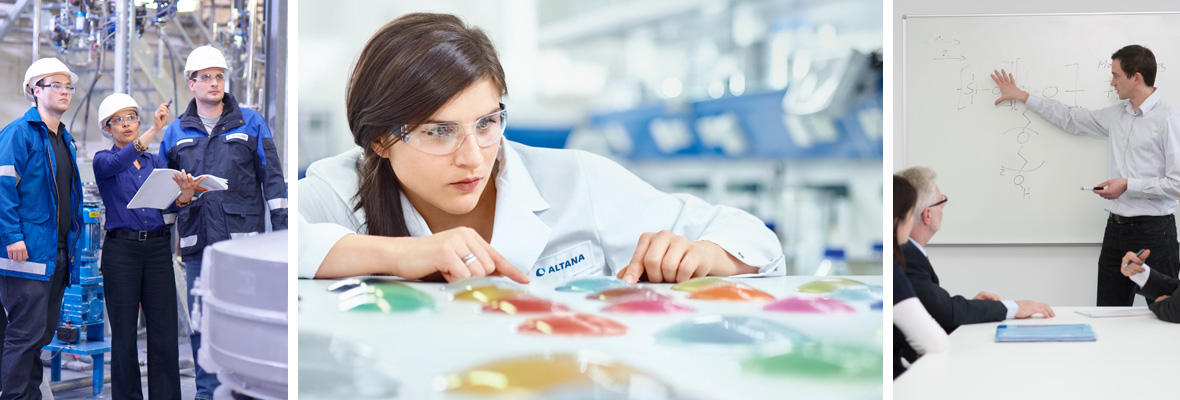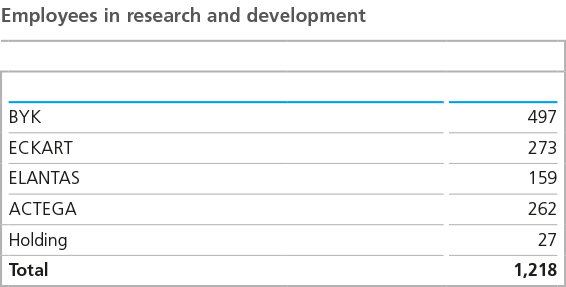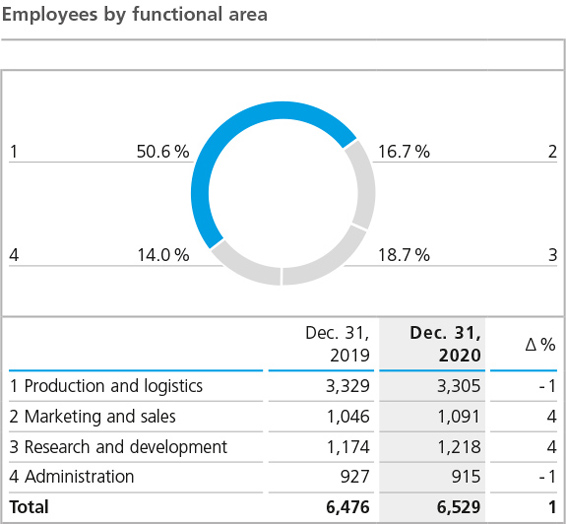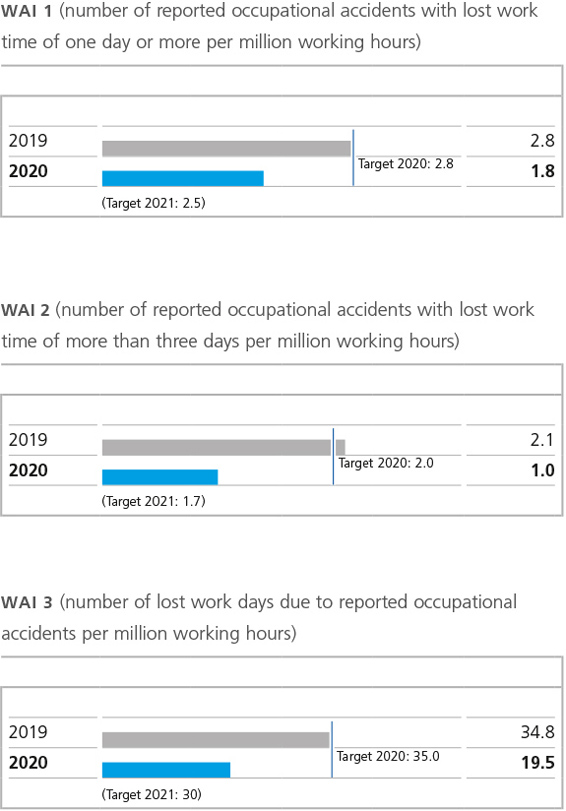Letter from the Management Board | About This Report | Sustainability Management | Corporate Bodies and Management | Report of the Supervisory Board | ALTANA in Everyday Life | Group Management Report | Products | Safety and Health | Environment | Human Resources | Social Commitment | Consolidated Financial Statements (condensed version) | Multi-Year Overview | Global Compact: Communication on Progress (COP) | ALTANA worldwide | List of Full Ownership | Overview - About This Report | Contact
Innovation
As a specialty chemicals company, innovations are an important factor for ALTANA, enabling us to offer our customers new, competitive solutions and at the same time to meet cutting-edge requirements regarding performance profile, costs, environmental protection, and sustainability. Thanks to close cooperation with our customers we are integrated into new fields of development at an early stage and thus can develop customized solutions quickly and reliably. We build on existing competencies, on the one hand, and gain access to new ones on the other, in order to continuously adapt our product portfolio to market and customer needs. To this end, our researchers and developers have access to the latest analytical methods in our chemical laboratories and application-technology test laboratories. Numerous awards from our customers underscore our success as an innovative solutions provider.
In addition to the activities in the business divisions, selected innovations are initiated and coordinated at the ALTANA level, aimed at tapping new business fields and absorbing technology and market trends. This is achieved through different procedures, namely, through the ALTANA Institute, the central management of technology platforms, as well as corporate venturing investments.
With the help of the ALTANA Institute, external networks and close cooperation with universities and research institutes around the world are used to harness outside impetus. The technology transfer of the first completed projects to the divisions, which was initiated in 2019, was successfully continued in 2020. In addition, new cooperation partners from Germany and abroad were added to the network and new research projects were launched with them.
In the 2020 fiscal year, ALTANA invested more in technology platforms than the year before. In 2019, the activities of the Printed Electronics platform had been integrated into the ELANTAS division. In the process, we used existing structures in the area of sales and market penetration to optimize the placement of the product portfolio with our customers, enabling us to achieve synergies. Furthermore, we were able to transfer numerous customer projects to the application test phase, and consequently commercialization can take place in the coming year. We developed a versatile product portfolio for 3D printing via the Cubic Inks technology platform. In close cooperation with dp polar GmbH, in which ALTANA holds a share, this ink portfolio is used in development partnerships with customers to deliver efficient and sustainable solutions through innovative polar printing technology. The laser transfer technology platform HELIOSONIC also managed to expand its pigment portfolio and thus increasingly enter into strategic development partnerships beyond the graphic arts industry. In 2020, for example, the first feasibility studies were carried out in the security printing and electronics sectors. On the basis of this development work with customers, a new prototype printing press was designed, which is scheduled to go into operation in 2021.
Thanks to the close cooperation between the central departments Corporate Innovation and Corporate Venturing, ALTANA can continuously examine technology and market potential and enter new attractive markets by means of targeted investments in innovative technology companies. In this context, ALTANA acquired a stake in the company TAU ACT GmbH, Berlin, in the 2020 fiscal year.
The basis for our innovative strength is an open and dynamic corporate culture that gives the 1,218 employees in our worldwide research and development centers freedom for creative and entrepreneurial action. The equipment in our development centers enables our employees to turn their ideas into market-ready solutions. Although 2020 was characterized by pandemic-related uncertainties, our research and development expenses in the area of innovation decreased only slightly compared to the previous year, amounting to € 163.4 million in the year under review (previous year: € 165.6 million). The slight increase in research and development expenses to 7.5 % of sales (previous year: 7.4 %) is attributable in part to the overall decline in sales. But it is also linked to the achievement of important milestones and the implementation of individual customer requirements in future innovative products, and supports the long-term orientation of our innovation activities.
At the end of 2020, the companies of the ALTANA Group employed 6,529 people worldwide (previous year: 6,476). The slight increase of 53 people, or 1 %, compared to the prior year is solely due to acquisitions, especially in the ACTEGA division (+ 68 employees).
In the BYK division, the number of employees fell slightly by 40 to 2,307 (previous year: 2,347). The workforce mainly decreased in production areas of the BYK companies in the U.S. and Germany as part of natural fluctuation.
In the ECKART division, staff numbers fell by 7 to 1,694 in the course of 2020 (previous year: 1,701). The slight decrease was the result of opposing effects. While the headcount at the American sites decreased by 13, 10 new employees were added at the Hartenstein and Wackersdorf sites in Germany. The changes mainly affected production. Due to the acquisition of the British company Aluminium Materials Technologies Ltd. (AMT), 4 new employees were added.
ELANTAS also recorded a slight decline of 7 employees to 1,071 (previous year: 1,078). The development within the division was mixed. While there was a slight decrease in the number of staff in production and research, the workforce in sales increased to a small extent.
In the ACTEGA division, the number of employees increased most significantly over the course of the year, by 90 to 1,238 (previous year: 1,148). The main driver was the acquisition of Schmid Rhyner AG, Switzerland, resulting in the addition of 68 new employees at the end of the year. The ACTEGA company in Brazil also recorded an increase, hiring 18 additional employees, who mainly work in production and sales as well as research and development.
Staff numbers of the Group holding companies rose by 17 to 219 in the past fiscal year (prior year: 202). The largest increase was recorded at ALTANA Management Services GmbH, with 10 additional employees.
The functional structure of the workforce did not alter significantly in the 2020 fiscal year. With 51 % or 3,305 people (previous year: 3,329), most of the employees continued to work in production. The research and development workforce increased by 44 to 1,218 in 2020 (previous year: 1,174). The number of employees in marketing and sales also rose, by a total of 45, during 2020. In the year under review, 915 people were employed in administration (previous year: 927).
In 2020, there were only minor shifts in the regional structure compared to the previous year. With 4,203 employees (previous year: 4,122), the European Group companies continued to employ by far the largest number of people.
3,376 (previous year: 3,353) were employed in Germany at the end of the year, the majority of them at ECKART’s and BYK’s largest production sites, in Hartenstein and Wesel, respectively. The number of employees in the Americas decreased slightly by 35 from 1,496 in the previous year to 1,461 at the end of 2020, with the reduction primarily recorded in North American companies. The number of people working for Asian Group companies increased slightly from 858 in the previous year to 865.
At the end of the 2020 fiscal year, 1,721 women and 4,808 men were employed at ALTANA. 90 % of all employees had an unlimited and 10 % a limited employment contract. This ratio was virtually the same for both genders. At the end of 2020, 75 % of the female employees were working full-time and 25 % part-time. 98 % of the male employees worked full-time. Apart from its own employees, 140 people from employment agencies worked for the ALTANA Group on December 31, 2020.
ALTANA continues to compete internationally for specialists and managers. Like all companies in the chemical industry, in the years to come the ALTANA Group, particularly in Europe, will enter a phase that due to the demographic development has made precision succession planning indispensable. As a result, talent management and human-resource development have played a key role for a few years now in ALTANA’s agenda for the future (Keep Changing Agenda). The aims are to mobilize people at ALTANA, to increase diversity at all levels, to further develop our leadership culture, and in doing so to strengthen our entrepreneurial thinking and action.
To achieve these goals, we examined and revised existing personnel tools in 2020 and embedded them in a uniform, overarching, and standardized process. The focus was on the conceptual design and further development of the so-called “Talent Cycle.” This process encompasses employee support from recruitment to talent identification and development to career and succession planning. Key elements are the compass dialog (annual employee appraisal) and the talent conferences, which serve to calibrate performance and potential assessments by managers. In the future, these meetings will take place locally, divisionally, and globally. On account of the pandemic, the introduction of the new process had to be postponed from 2020 to 2021.
The “HR Transformation” project launched in previous years, which serves to strategically reposition personnel, was successfully continued in 2020. The master data and organizational structures were combined in a uniform global system for the first time. In the future, as part of the “HR Transformation,” the unified HR master data will serve redefined and further developed HR processes, such as talent management and further training. In 2020, the “Performance & Goals” and “Learning Management“ modules were mapped in digital system-based processes. The global rollout of the new processes in the area of “Learning” was launched in 2020 and will continue for “Performance & Goals” in 2021. The aim is to enable the HR organizations to grow closer together at an international level, employees to be supported more comprehensively across divisions and national borders, and an international leadership and HR culture to be created.
Environment and Safety
Occupational safety and environmentally compatible management are key components of ALTANA’s corporate strategy and are becoming increasingly important. The ALTANA Group measures progress in the area of environmental protection using specific key figures, such as the consumption of natural gas and electricity as energy sources and the resulting greenhouse gas emissions, and in the area of safety with the help of accident figures. In terms of environmental protection, our goal is to continuously reduce energy consumption at all of our sites and in all areas and to promote the use of energy from renewable sources in order to achieve climate neutrality for the ALTANA Group by 2025. ALTANA plans to compensate for the CO2 emissions that cannot be avoided by 2025 by financing equivalent climate protection projects. In the field of safety, the primary objective is to reduce the number of accidents.
The issue of safety is a top priority at ALTANA. ALTANA ensures continuous improvement in the safety of its employees by means of various technical and organizational measures tailored to the production conditions at the sites and to the laws and regulations that apply there. To achieve a uniform safety culture, ALTANA also relies on targeted employee training programs. All of our worldwide sites have established their own safety organization, which is responsible, among other things, for complying with all local occupational safety regulations, for training and education measures, and for recording and evaluating accidents. Throughout the Group, the Work Accident Indicator (WAI) serves as the most important key performance indicator for recording and evaluating the development of occupational safety at all sites on the basis of reported accidents with lost work days. Three key figures are defined for better comparability: WAI 1 refers to the number of reported accidents with lost work time of one day or more per million working hours. WAI 2 comprises the number of reported occupational accidents with lost work time of more than three days per million working hours. And WAI 3 represents the number of lost work days due to reported occupational accidents per million working hours. ALTANA determines the working hours on the basis of the actual hours worked. If such recording is not possible, a qualified estimate of the average hours worked is made. Accidents are recorded directly on site and reported to a defined group of persons within 48 hours. On a quarterly basis, the reported accidents with lost work days are evaluated in a global IT system. Subsequently, the evaluations are made available to all responsible persons (such as the Management Board, division presidents, managing directors, and EH&S experts). On the basis of this data, ALTANA’s Management Board, together with the EH&S department, sets target values for the three WAIs for each year, which apply equally to all companies of the ALTANA Group.
For 2020, ALTANA again lowered the target values for all three accident indicators (WAI 1: 2.8; WAI 2: 2.0; and WAI 3: 35.0), once again emphasizing how important occupational safety is for the Group. In the year under review, we succeeded in achieving these target values and significantly reducing the accident figures in all three categories. Globally, 19 accidents with lost work days were reported at ALTANA, 13 less than in the previous year. Based on the hours worked, the WAI values are as follows: WAI 1: 1.8 (previous year: 2.8); WAI 2: 1.0 (previous year: 2.1); and WAI 3: 19.5 (previous year: 34.8). ALTANA achieved these good results by means of various measures to improve employees’ safety awareness and the Group’s safety culture as a whole. The further development and implementation of technical and organizational measures as well as behavior-based safety training are intended to lead to safe action in every situation.
ALTANA has also been addressing the issue of energy efficiency and the associated greenhouse gas emissions for several years. In addition to absolute values, energy consumption is set in relation to the quantity of finished goods produced. ALTANA establishes annual reduction targets for energy consumption in relation to the quantity of finished goods produced. The recording and calculation of emissions relates, as Scope 1, to direct greenhouse gas emissions from emission sources owned or controlled by the Group. These include, for example, the combustion of primary energy sources in the course of heat generation and fuel consumption in the company’s own vehicle fleet. Scope 2 includes indirect greenhouse gas emissions from the purchase of electricity for specific services. They are recorded and calculated in accordance with the standard “A Corporate Accounting and Reporting Standard - Revised Edition” of the Greenhouse Gas Protocol initiative. The energy consumption of all production sites included in the scope of consolidation is recorded and evaluated in a global IT system. The CO2 equivalents for Scope 2 are calculated based on conversion factors (g CO2/kWh) defined by International Energy Agency (IEA) in line with the currently published values (2018) and with the aid of emission factors of the electricity supplier or an individual electricity product, and for Scope 1 from the IPCC (International Panel on Climate Change).
Actual consumption is generally verified by the companies by means of bills. If this is not possible for the last two months of the reporting year, the companies first make a qualified estimate of the values. As a result, in the following year – as soon as all bills are available – the prior-year figure may still be adjusted retrospectively. In 2020, ALTANA expects a total energy consumption of 668,493 MWh (previous year: 674,853 MWh). The main energy sources were natural gas (375,676 MWh) and purchased electricity (247,738 MWh). ALTANA set a target value of 1.26 MWh/t for the specific energy parameter – based on one ton of finished goods – for 2020. For the reporting period, a value of 1.28 MWh/t was achieved. The deviation of this key figure is mainly due to the fact that, as a result of the coronavirus pandemic, the target value for the planned absolute quantity of produced finished goods could not be achieved and the amount of energy required for this could not be reduced to the same extent.
This resulted in a calculated total of 90,217 metric tons of CO2 equivalents in Scope 1. In addition, biogenic CO2 emissions accounted for 332 metric tons of CO2 equivalents. For the purchased electricity amounting to 247,738 MWh, the same amount of certificates of origin was acquired in accordance with recognized quality standards (for example CoO for Europe, IREC for China, and GREEN-E for the U.S.). This is electricity that is generated from renewable energy sources and whose origin is made transparent by means of a certificate of origin. This results in a value of 92,553 metric tons of CO2 equivalents according to the “market-based” method. The electricity purchased by ALTANA included in this figure corresponds to CO2 emissions of zero.






